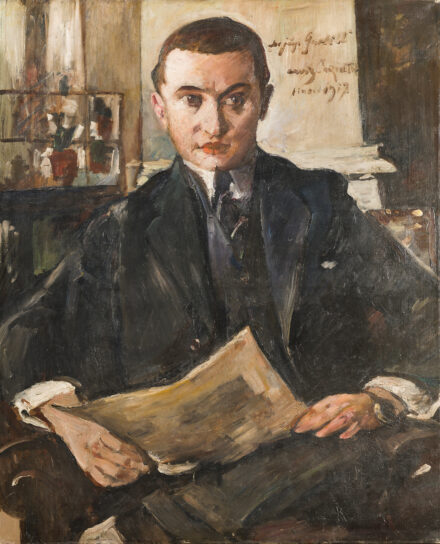Lovis Corinth, Portrait of Wolfgang Gurlitt, 1917
Collection Lentos Kunstmuseum Linz

Oil on canvas, 113 x 90,5 cm
Collection Lentos Art Museum Linz, Inv. Nr. 1
What an incredibly penetrating gaze this young man is gifted with! Painter Lovis Corinth has skilfully used the light-dark modelling of the face to draw attention to the subject’s large dark eyes, lending the portrait a somewhat sombre character. It is largely reduced to tones of black and white and almost entirely eschews other colours. In this way, the painter focusses even more powerfully on the personality of the subject, who in his elegant dark suit is seated on a chair. He exudes self-assurance and poise. Has he just raised his eyes from a newspaper? No, this young man is an art dealer, and what he is holding in his hands is a work of graphic art.
The subject is Wolfgang Gurlitt or, more precisely: “Der junge Gurlitt [Gurlitt junior]”, as the title of the painting has it. The painter has placed his own signature in full view next to the face of the subject, in a phrase reminiscent of an old master: “Lovis Corinth pinxit 1917” – “Lovis Corinth painted it in 1917”. Wolfgang Gurlitt was then twenty-nine years old. One year later he was to succeed his father in the management of a Berlin art dealership, an outstanding avant-garde gallery where, among other artists, Corinth was under contract.
At a later stage Wolfgang Gurlitt was to play a key role in the prehistory of the Lentos Kunstmuseum. In 1938 the Berlin gallery owner decided to move his collection of high-quality modern art to Austria for safety reasons. After World War II he left this collection to the City of Linz, where it forms the core of the holdings of the Lentos Kunstmuseum today.
The provenance of the painting is remarkable for an unexpected twist. Initially, the painting was on display at Berlin’s Nationalgalerie. The Nazis confiscated it in 1937 together with fifteen other works by Corinth and sold it at an auction in Switzerland. By a circuitous route it made its way back to Wolfgang Gurlitt, who left it to the institution that now goes under the name Lentos Kunstmuseum.